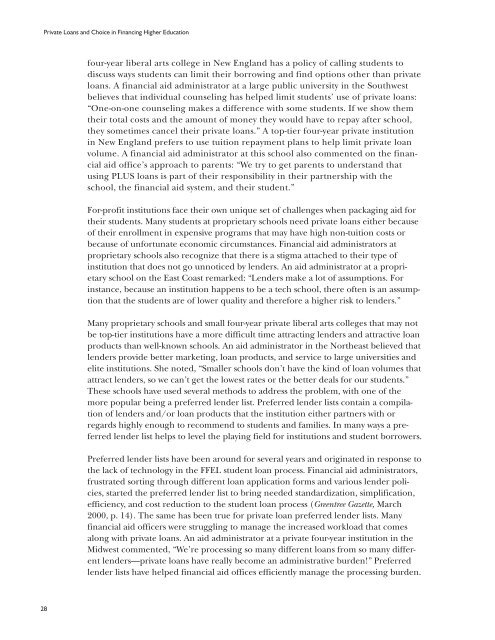Private Loans and Choice in Financing Higher Education - College ...
Private Loans and Choice in Financing Higher Education - College ...
Private Loans and Choice in Financing Higher Education - College ...
You also want an ePaper? Increase the reach of your titles
YUMPU automatically turns print PDFs into web optimized ePapers that Google loves.
<strong>Private</strong> <strong>Loans</strong> <strong>and</strong> <strong>Choice</strong> <strong>in</strong> F<strong>in</strong>anc<strong>in</strong>g <strong>Higher</strong> <strong>Education</strong>four-year liberal arts college <strong>in</strong> New Engl<strong>and</strong> has a policy of call<strong>in</strong>g students todiscuss ways students can limit their borrow<strong>in</strong>g <strong>and</strong> f<strong>in</strong>d options other than privateloans. A f<strong>in</strong>ancial aid adm<strong>in</strong>istrator at a large public university <strong>in</strong> the Southwestbelieves that <strong>in</strong>dividual counsel<strong>in</strong>g has helped limit students’ use of private loans:“One-on-one counsel<strong>in</strong>g makes a difference with some students. If we show themtheir total costs <strong>and</strong> the amount of money they would have to repay after school,they sometimes cancel their private loans.” A top-tier four-year private <strong>in</strong>stitution<strong>in</strong> New Engl<strong>and</strong> prefers to use tuition repayment plans to help limit private loanvolume. A f<strong>in</strong>ancial aid adm<strong>in</strong>istrator at this school also commented on the f<strong>in</strong>ancialaid office’s approach to parents: “We try to get parents to underst<strong>and</strong> thatus<strong>in</strong>g PLUS loans is part of their responsibility <strong>in</strong> their partnership with theschool, the f<strong>in</strong>ancial aid system, <strong>and</strong> their student.”For-profit <strong>in</strong>stitutions face their own unique set of challenges when packag<strong>in</strong>g aid fortheir students. Many students at proprietary schools need private loans either becauseof their enrollment <strong>in</strong> expensive programs that may have high non-tuition costs orbecause of unfortunate economic circumstances. F<strong>in</strong>ancial aid adm<strong>in</strong>istrators atproprietary schools also recognize that there is a stigma attached to their type of<strong>in</strong>stitution that does not go unnoticed by lenders. An aid adm<strong>in</strong>istrator at a proprietaryschool on the East Coast remarked: “Lenders make a lot of assumptions. For<strong>in</strong>stance, because an <strong>in</strong>stitution happens to be a tech school, there often is an assumptionthat the students are of lower quality <strong>and</strong> therefore a higher risk to lenders.”Many proprietary schools <strong>and</strong> small four-year private liberal arts colleges that may notbe top-tier <strong>in</strong>stitutions have a more difficult time attract<strong>in</strong>g lenders <strong>and</strong> attractive loanproducts than well-known schools. An aid adm<strong>in</strong>istrator <strong>in</strong> the Northeast believed thatlenders provide better market<strong>in</strong>g, loan products, <strong>and</strong> service to large universities <strong>and</strong>elite <strong>in</strong>stitutions. She noted, “Smaller schools don’t have the k<strong>in</strong>d of loan volumes thatattract lenders, so we can’t get the lowest rates or the better deals for our students.”These schools have used several methods to address the problem, with one of themore popular be<strong>in</strong>g a preferred lender list. Preferred lender lists conta<strong>in</strong> a compilationof lenders <strong>and</strong>/or loan products that the <strong>in</strong>stitution either partners with orregards highly enough to recommend to students <strong>and</strong> families. In many ways a preferredlender list helps to level the play<strong>in</strong>g field for <strong>in</strong>stitutions <strong>and</strong> student borrowers.Preferred lender lists have been around for several years <strong>and</strong> orig<strong>in</strong>ated <strong>in</strong> response tothe lack of technology <strong>in</strong> the FFEL student loan process. F<strong>in</strong>ancial aid adm<strong>in</strong>istrators,frustrated sort<strong>in</strong>g through different loan application forms <strong>and</strong> various lender policies,started the preferred lender list to br<strong>in</strong>g needed st<strong>and</strong>ardization, simplification,efficiency, <strong>and</strong> cost reduction to the student loan process (Greentree Gazette, March2000, p. 14). The same has been true for private loan preferred lender lists. Manyf<strong>in</strong>ancial aid officers were struggl<strong>in</strong>g to manage the <strong>in</strong>creased workload that comesalong with private loans. An aid adm<strong>in</strong>istrator at a private four-year <strong>in</strong>stitution <strong>in</strong> theMidwest commented, “We’re process<strong>in</strong>g so many different loans from so many differentlenders—private loans have really become an adm<strong>in</strong>istrative burden!” Preferredlender lists have helped f<strong>in</strong>ancial aid offices efficiently manage the process<strong>in</strong>g burden.28
















